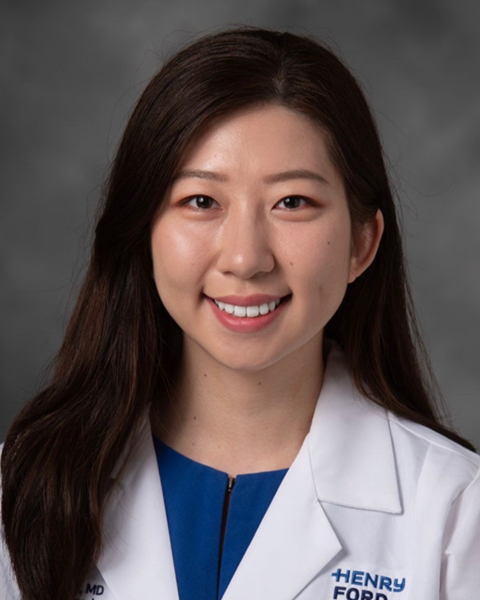PQA 03 - PQA 03 Gynecological Cancer, Pediatric Cancer, and Professional Development Poster Q&A
3516 - Outcomes and Patterns of Failure for Women with FIGO Stage I-II Uterine Non-Endometroid Carcinoma after Surgical Staging, Adjuvant Chemotherapy and Vaginal Cuff Brachytherapy
Monday, September 30, 2024
8:00 AM - 9:00 AM ET
Location: Hall C
Screen: 11

Yoonsun Jee, MD
Henry Ford Hospital-Henry Ford Cancer Institute
Detroit, MI
Presenter(s)
Y. Jee1, I. Aref1, A. Wang2, J. Huang-Vredevoogd1, M. Hijaz3, and M. A. Elshaikh1; 1Department of Radiation Oncology, Henry Ford Cancer Institute, Detroit, MI, 2Henry Ford Health, Detroit, MI, 3Department of Gynecologic Oncology, Henry Ford Cancer Institute, Detroit, MI
Purpose/Objective(s): Limited data exist on the recurrence patterns of women with early-stage uterine non-endometrioid carcinoma following adjuvant therapies. This study aims to investigate recurrence patterns and survival outcomes in these patients. Materials/
Methods: Following IRB approval, our database was queried for patients who underwent surgical staging from 1/1990 to 6/2023 with 2009 FIGO stage I-II uterine non-endometrioid carcinoma at our institution. Inclusion criteria encompassed patients who received adjuvant chemotherapy (carboplatin and paclitaxel) and vaginal cuff HDR brachytherapy. Exclusions were made for synchronous malignancies and positive peritoneal cytology. Recurrence-free (RFS), disease-specific (DSS), and overall survival (OS), along with recurrence patterns, were analyzed. Multivariable Cox proportional hazards regression modeling identified predictors for these survival endpoints.
Results: A total of 134 patients (median age: 65, median follow-up: 57 months) were included. 117 patients had stage I disease (87%), 71 patients (53%) had uterine serous carcinoma, and 23% had carcinosarcoma. Median lymph nodes examined was 8 (range: 2-20). Recurrence occurred in 24 patients (17.9%), with distant recurrence as the most common first site (75.0%), followed by pelvic only recurrence in 3 patients (37.5%). 5-year RFS, DSS, and OS were 79%, 85%, and 80%, respectively. Lymphovascular space invasion (LVSI) and FIGO stage II disease were independent predictors of worse RFS (LVSI HR 3.14, p=0.012; stage II HR 3.04, p=0.031) and worse DSS (LVSI HR 3.04, p=0.035; stage II HR 4.91, p=0.004). Presence of any comorbidity burden, as indicated by Charlson Comorbidity Index (HR 2.27, p=0.040) and FIGO stage II disease (HR 2.82, p=0.038) predicted worse OS.
Conclusion: Favorable oncologic outcomes for stage I-II uterine non-endometroid carcinoma were observed with adjuvant vaginal cuff brachytherapy and chemotherapy. Distant recurrence predominated, highlighting the need for further optimization of adjuvant systemic therapy.
Purpose/Objective(s): Limited data exist on the recurrence patterns of women with early-stage uterine non-endometrioid carcinoma following adjuvant therapies. This study aims to investigate recurrence patterns and survival outcomes in these patients. Materials/
Methods: Following IRB approval, our database was queried for patients who underwent surgical staging from 1/1990 to 6/2023 with 2009 FIGO stage I-II uterine non-endometrioid carcinoma at our institution. Inclusion criteria encompassed patients who received adjuvant chemotherapy (carboplatin and paclitaxel) and vaginal cuff HDR brachytherapy. Exclusions were made for synchronous malignancies and positive peritoneal cytology. Recurrence-free (RFS), disease-specific (DSS), and overall survival (OS), along with recurrence patterns, were analyzed. Multivariable Cox proportional hazards regression modeling identified predictors for these survival endpoints.
Results: A total of 134 patients (median age: 65, median follow-up: 57 months) were included. 117 patients had stage I disease (87%), 71 patients (53%) had uterine serous carcinoma, and 23% had carcinosarcoma. Median lymph nodes examined was 8 (range: 2-20). Recurrence occurred in 24 patients (17.9%), with distant recurrence as the most common first site (75.0%), followed by pelvic only recurrence in 3 patients (37.5%). 5-year RFS, DSS, and OS were 79%, 85%, and 80%, respectively. Lymphovascular space invasion (LVSI) and FIGO stage II disease were independent predictors of worse RFS (LVSI HR 3.14, p=0.012; stage II HR 3.04, p=0.031) and worse DSS (LVSI HR 3.04, p=0.035; stage II HR 4.91, p=0.004). Presence of any comorbidity burden, as indicated by Charlson Comorbidity Index (HR 2.27, p=0.040) and FIGO stage II disease (HR 2.82, p=0.038) predicted worse OS.
Conclusion: Favorable oncologic outcomes for stage I-II uterine non-endometroid carcinoma were observed with adjuvant vaginal cuff brachytherapy and chemotherapy. Distant recurrence predominated, highlighting the need for further optimization of adjuvant systemic therapy.
